44 percent. That was the click-through-rate of the first ever banner ad, purchased by AT&T on HotWired.com in 1994

Nowadays, this ad would be considered the scum of clickbait. No sane person would ever click on it.
Fortunately, online advertising has rapidly evolved since the 90’s, so you don’t have to rely on attention-repellent banner ads anymore. You can create engaging ads in multiple formats and target people who actually need your product or service.
Let’s read on to dive deeper into modern online advertising and learn the capabilities of the most effective advertising channels on the internet today.
Online Advertising: Everything You Need to Know in 2018
1. Paid Search Advertising
With over 3.5 billion search queries on Google everyday, paid search — where you pay Google or other search engines to advertise your content on SERPs for relevant keywords — is one of the most popular and effective types of online advertising
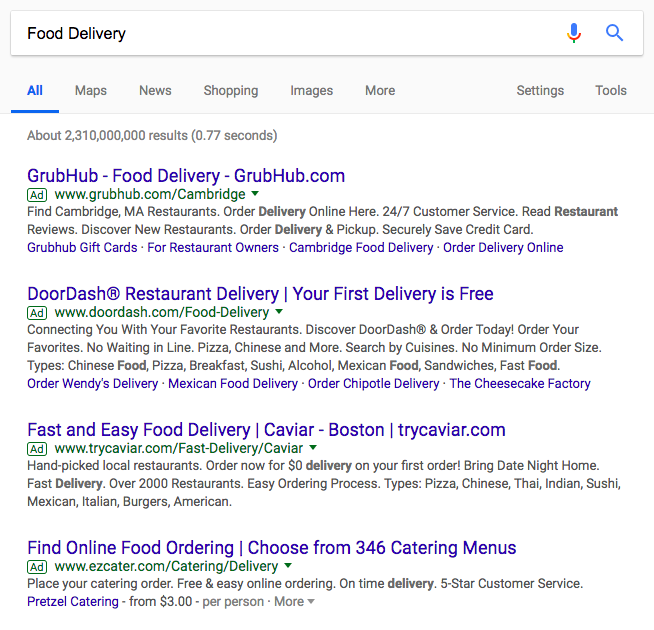
Naturally, there’s enormous demand for the top ad rankings, so Google triggers an auction anytime there are at least two advertisers bidding for keywords that are related to search queries that users consistently enter into Google.

Picture Credit: WordStream
Advertisers then categorize keywords and their corresponding ad copy and web page into groups, pick the group they want to bid on, and choose their maximum bid. Google will select a keyword from the advertiser’s ad group that they deem most relevant to users’ search queries and enter it into the auction.
A Google auction isn’t like your typical auction for antiques, though. They want to level the playing field when it comes to leveraging the size of their reach, so instead of the highest bidder always winning the auction, the bidder with the highest Ad Rank always wins.
AdRank is calculated by multiplying your maximum cost-per-click bid with the quality of score your ad, which is calculated by measuring your page’s relevance to the keyword, user experience, and click-through-rate. This means organizations can’t acquire the top ranking for any keyword they want just because they have the biggest ad budgets. Their content has to be engaging.
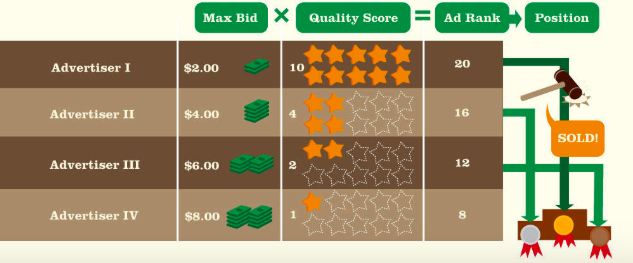
Picture Credit: WordStream
Google AdWords wants to incentivize the best advertisers to advertise the best content on their SERPs, so they reward ads that have high quality scores with higher ad rankings and lower cost-per-clicks.
In the same vein, they also want to discourage bad advertisers from advertising bad content, so advertisers with low quality scores will usually only acquire a high ad position if they pay a huge cost-per-click bid. If they want to pay lower a cost-per-click, they have to settle with stooping at the bottom of the ad rankings.
If you win a Google auction, your actual cost-per-click is calculated by the second highest ad rank divided by your quality score, plus one cent. The only time you’ll pay your maximum bid is if you’re the only bidder in the auction or if you make the highest bid in the auction, but you have the lowest ad rank. In this case, you’ll acquire the last ad rank.
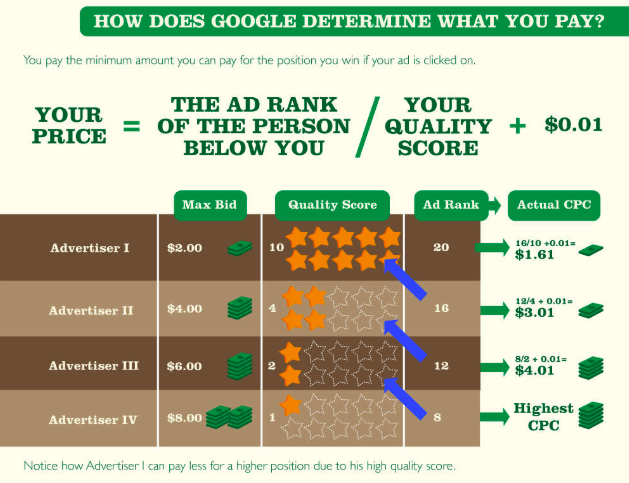
Picture Credit: WordStream
2. Paid Social Advertising
Over 80% of the U.S. population uses social media, but since social networks are all trying to monetize their audiences as much as possible, organic reach is at an all-time low. The quickest and most effective way to meet your audience where they spend most of their time is through social advertising.
On paid social, advertisers have a lot of opportunity to optimize their campaigns. They can choose the objective of their ad campaigns, the type of ad they promote, and the targeting of their ads, which can get incredibly granular. Here’s a summary of Facebook, LinkedIn, Instagram, and Twitter’s advertising capabilities.
With almost 1.5 billion daily active users who spend an average of 41 minutes on the platform everyday, Facebook boasts the largest and most engaged user base out of all the social media platforms. And to effectively monetize their audience, they’ve built the best targeting tools and the most cost-effective ads for advertisers.
When you create an ad campaign, your first step is to choose your campaign’s goal. You can either amplify your brand’s awareness, consideration, or conversions. Here are the KPIs for each objective:
Awareness
Consideration
- Traffic
- Engagement
- App installs
- Video views
- Lead generation
- Messages
Conversion
- Conversions
- Catalog Sales
- Store Visits
After you choose your ad campaign’s objective, you’ll pick the type of ad you want to promote, which can be a link ad, image ad, video ad, carousel ad, slideshow ad, link ad, dynamic ad, collection ad, lead generation ad, and messenger ad.
If you don’t know what Facebook’s collection, dynamic, lead, or messenger ads are, here’s a quick rundown of them:
- Collection Ads promote your products, allowing potential customers to learn about your product without leaving Facebook. They also drive traffic to your product pages.
- Dynamic Ads automatically promote products to people who have expressed interest in them on your website, app, or somewhere else on the internet. All you have to do is upload your product catalog and set up one campaign. Facebook will keep finding the right people for each of your products until you turn it off.
- Lead Generation Ads generate leads by pre-populating forms with people’s information that they entered on Facebook for your brand’s email subscription, free trials, and registrations.
- Facebook Messenger Ads let you leverage the popularity and convenience of the app to generate more brand awareness and revenue — two billion messages are sent between people and businesses each month, and 53% of people are willing to buy from a company that they can directly message. You can display Messenger ads in the home screen of the messenger app, create newsfeed ads that prompt a conversation with users in the app, and send sponsored re-engagement messages to people who have already started a conversation with you on Messenger.
When you finish designing and choosing the format of your ad, you’ll get to leverage the most granular and powerful targeting tools on social media to build your audience.
If you want to build your audience from scratch, you can use the Core Audiences feature, which lets you choose from hundreds of options to target specific users with ads. Facebook segments the options by demographics, interests, and behavior. Here’s a list of all the targeting options:
Demographic Data
- Location
- Age
- Gender
- Languages
- Relationship Status
- Education Level
- Field of Study
- Schools
- Undergrad Years
- Employers
- Job Title
- Industry
- Income
- Net worth
- Home Type
- Home Ownership
- Household Composition
- Ethnic Affinity
- Generation
- Parental Status
- Life Events
- Political Affiliation
Interests Data (Interests, activities, and pages liked of the following topics)
- Business & Industry
- Entertainment
- Family & Relationships
- Fitness & Wellness
- Food & Drink
- Hobbies & Activities
- Shopping & Fashion
- Sports & Outdoors
- Technology
Behavioral Data (Purchase behaviors or intent, device usage, and other activities surrounding the following topics)
- Automotive
- B2B
- Business Travelers
- Charitable Donations
- Digital Activities
- Expats
- Financial
- Job Role
- Media
- Mobile Device User
- Page Administrators
- Purchase Behavior
- Travel
- Residential Profiles
- Seasonal & Events
- Type of Web Browser
To effectively target the right audience and optimize your paid social budget, it’s crucial that you have a deep understanding of your ideal customer. If your buyer personas are highly detailed and accurate, you’ll be able to leverage most of the targeting options and make your ads as relevant as possible.
If you don’t want to build out your own audience, you can let Facebook do it for you. By using the lookalike audiences feature, you can find and target audiences that are similar to your customers or prospects. All you have to do is import a list of their contact information into Facebook.
If you want to target the people who already have a relationship with your brand, use the Custom Audience feature. By just importing data from your CRM or customer contact lists into Facebook, you can place retargeting ads in front of current customers, site visitors, and mobile users.
LinkedIn has a significantly smaller reach than Facebook, which hovers around 250 million monthly active users, but since professionals constantly update their career information and specifically look for content about business on the platform, LinkedIn is considered the best social network for B2B lead generation.
Costs are usually higher on LinkedIn compared to every other social network, but it generally produces the highest conversion rates and lead quality, which helps justify the platform’s lofty advertising fees.
For example, at HubSpot, we advertised an eBook for finance marketers on both LinkedIn and Facebook. After the campaign, we discovered that LinkedIn clicks were four times more expensive than Facebook clicks. But we also found out that LinkedIn conversions, the metric that mattered the most, were half the cost of Facebook conversions. In terms of this eBook’s topic and target audience, LinkedIn was the best choice for generating leads.
When you advertise on LinkedIn, you can choose from three marketing objectives: build brand awareness, drive website traffic, or generate leads and convert prospects.
After you set your goal, you can either advertise sponsored content like posts or videos in LinkedIn’s news feed, sponsored InMail in your audience’s LinkedIn inbox, and text ads, which are placed to the right of the news feed.
Once you finish picking your ad format, you’ll start doing the fun stuff. LinkedIn’s targeting capabilities are a B2B marketer’s dream — most professionals’ information is up to date on LinkedIn, so you can accurately target your ideal customers based off their company information, experience, education, and interests & identity. Here’s all of LinkedIn’s targeting options:
Company
- Company Name
- Company Size
- Industry
- Followers
- Connections
Experience
- Job Title
- Job Function
- Job Seniority
- Years of Experience
Education
- Schools
- Degrees
- Fields of Study
Interests & Identity
- Skills
- Groups
- Age
- Gender
- Location
With 500 million daily active users, and 64% of their users aged 18-29, Instagram is the best platform for attracting the attention of millennials and Gen Z’ers. Facebook owns Instagram, so naturally their objectives for ad campaigns align with Facebook’s: awareness, consideration, and conversion. Here are all the KPIs associated with each category:
Awareness
- Reach
- Reach & Frequency
- Brand Awareness
- Local Awareness
Consideration
- Website Clicks
- Video Views
- Reach & Frequency
Conversion
- Website Conversions
- Dynamic Ads on Instagram
- Mobile App Installs
- Mobile App Engagement
After you set your goal, you can create four types of ads: photo, video, carousel, and story ads.
In terms of targeting, Instagram’s capabilities are the lite version of Facebook’s. You can target people based on their location, demographics, interests, and behaviors. Here are all of Instagram’s targeting options.
Location
- States
- Provinces
- Cities
- Countries
Demographics
Interests
- App Usage
- Ads Clicked
- Accounts Following
Behaviors
- Activities your audience does on and off Instagram and Facebook
Similar to Facebook, Instagram also offers custom audiences, lookalike audiences, and automated targeting, which analyzes your current audience’s location, demographics, and interests to create an audience who might be interested in your business.
Twitter lost one million active users last quarter, but they still have 335 million monthly active users — 80% of who live outside of the United States. If you want to extend your international reach, especially in Asia, Europe, and South America, Twitter advertising is your best avenue for success.
When you advertise on Twitter, there are five marketing objectives you can choose from:
- Awareness & Reach
- Tweet Engagements
- Followers
- Website Clicks
- App Installs
After you set your objective, you can promote your Tweets with two tools: Twitter Promote and Twitter Ad Campaigns. Twitter Promote advertises your first 10 daily organic tweets that pass a quality test to your target audience. All you have to do is specify five of your potential followers’ interests or metro locations, and Twitter will do the work for you.
If you use Twitter Ad campaigns, you set up advertising campaigns by yourself, where you can leverage the following targeting options:
- Language
- Gender
- Interest
- Relevant accounts
- Follower
- Device
- Behavior
- Tailored Audience
- Keyword
- Geography
3. Native Advertising
Publishers like BuzzFeed and The Dodo produce content that snowballs in popularity on social media almost every day. And they make money by helping other brands do it too. Brands will pay these publishers to craft posts and videos that follow the publishers’ formula for virality. They also pay publishers to distribute this sponsored content to their massive audience through social media and their website.
When you pay for a publisher’s native advertising services, you’ll be able to leverage their editorial expertise and audience reach to help your brand tell captivating stories to a bigger and better viewership.
During the creative process, you’ll collaborate with publishers to craft sponsored content that covers one of their main topics and looks like a regular piece of content on the publisher’s website. This way, even though your post is technically promotional, it won’t disrupt their audience’s browsing experience. They’ll enjoy reading your post and won’t feel like you or the publisher are advertising to them. This exposes your work to a huge, engaged viewership and attracts new followers to your brand.
Native advertising creates a symbiotic relationship between publishers and brands. Publishers who do sponsored content right reap the benefits of another revenue stream and gain more audience trust if they promote a native ad from a trustworthy brand — 41% of readers say they trust publishers even more if they publish with a trustworthy brand.
For brands, collaborating with prominent publishers can unleash unprecedented amounts of creativity to help them win over the publishers’ audience and boost engagement — 31% of readers say they’re more likely to buy from a brand after viewing their native ad, and T Brand Studio, the New York Times native ad business, crafted sponsored posts that captured as much engagement as some of nytimes.com’s highest-performing articles.
To find the optimal native advertising opportunities for your brand, try using StackAdapt or Nativo.
4. Pre- and Mid-Roll Advertising
Forcing people to suffer through a 30-60 second YouTube ad isn’t the best way to attract the attention of a new audience — it’ll just irritate them. But shortening video ads can actually engage viewers without testing their patience. According to Google, 90% of bumper ad campaigns boosted global ad recall by an average of 30%.
If you want to advertise on YouTube, where adults watch more content than they do any television network each month, you can leverage two types of video ads: TrueView ads and Bumper ads.
TrueView Ads
With TrueView ads, you’ll only pay for an ad when people watch its entirety, view it for at least 30 seconds, or click on its CTA. YouTube knows its users expect shorter ads, so they require non-skippable ads to be between 15-20 seconds long. If you want to leverage TrueView ads, you have two options to choose from: in-stream ads and video discovery ads.
- Instream ads play before the beginning of certain YouTube videos or on websites that have purchased Google video ad space on the Google Display Network. After the first 5 seconds of your ad, viewers can skip it, but YouTube allows you to place CTAs on your ads to drive traffic to your website or YouTube channel.
- Video discovery ads are videos that you can promote on YouTube’s homepage and the results page or recommendation section when users search for certain topics and keywords. If someone clicks and watches your ad, a companion banner display ad will appear to the right of the video, prompting viewers to learn more about your company.
Bumper Ads
Bumper ads are the shortest, yet most memorable YouTube ads. When YouTube plays such a short ad for their viewers, it can’t really bother them. And when brands craft these ads into fast, captivating stories, they can resonate with audiences. It’s hard to forget any of Geico’s bumper ads, am I right?
Bumper ads are up to six seconds long, appearing before, during, or after YouTube videos or on sites and apps that are on the Google Display Network. You’ll bid on each ad’s cost-per-thousand-impressions, so you’ll pay each time YouTube shows your ad 1,000 times.
Targeting
With over one billion users from more than 70 countries and access to the Google Display Network, YouTube offers some of the most granular targeting in the digital marketing space.
Using YouTube’s advertising tools, you can target audiences by their location, demographics, and interests. You can also remarket to past viewers, place your ads on certain properties, and place ads on videos about specific topics and keywords. Here’s every targeting option in each of these categories:
Location
Demographics
- Age
- Gender
- Parental Status
- Household Income
Interests
- People who have a strong interest in topics similar to the ones your channel covers.
- People who are going through certain life events like moving, graduating from college, or getting married.
- People who are actively researching and considering products or services that are similar to yours.
Remarketing
- Viewers who have had past interactions with your videos, TrueView ads, or YouTube channel
Placements
- YouTube Channels
- YouTube Videos
- Websites on the Display Network
- Apps on the Display Network
Topics
- If you target the “Fitness” topic, your ads will appear on YouTube videos about weight lifting.
Keywords
- Place ads on specific videos that are related to certain keywords.
5. Display Advertising
Display ads are a controversial topic in the digital marketing community. For almost 25 years, advertisers have abused them by tricking internet users into clicking misleading ads — some malicious display ads have even infected people’s computers with viruses. It’s easy to see why people have developed banner blindness and can’t stop downloading ad blockers: display ads have the reputation of being intrusive, distracting, and irrelevant.
On the other side of the spectrum, though, display advertising technology has advanced to the point where ad networks can leverage data and machine learning to offer advertisers more effective targeting strategies and consumers more relevant ads.
Ad networks like Google Display Network and Facebook’s Audience Network are the leaders in the banner ad renaissance. They can display your ads to the right target audience at the right place and time. And if you want more control of your advertising, they’ll let you decide where to place your ads. Below, we’ll cover each ad networks’ features and targeting capabilities:
Google Display Network
When you use Google’s Display Network, you can design visually appealing ads and place them on over two million websites and apps, YouTube, and Gmail. You can also build new audiences by targeting people who are most likely to be interested in your product or service and remarket website visitors just by importing a list of their contact information.
If you don’t want to build out your ideal audience or deal with bidding, you can let Google AdWords do it for you. Their automated targeting and bidding features can identify your highest converting audience for the best return on investment.
Facebook’s Audience Network
With Facebook’s Audience Network, brands can expand their Facebook ad campaigns off the social network, and use the same targeting data they use on the platform to advertise on a huge collection of websites and apps — publishers in Facebook’s audience network account for 50% more time spent in mobile apps than Snapchat and Twitter combined. Brands can place native ads, banner ads, full-screen ads, in-stream video ads, and rewarded video ads (watch this video ad to get more tokens!) on the network’s websites and apps that their Facebook audience frequently visits.

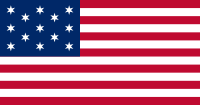

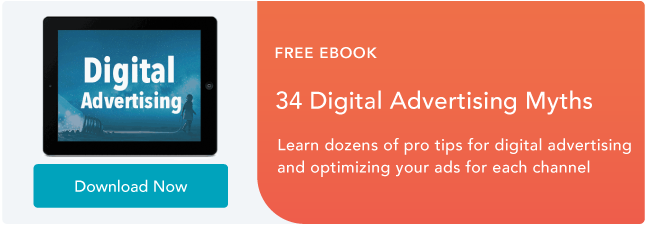
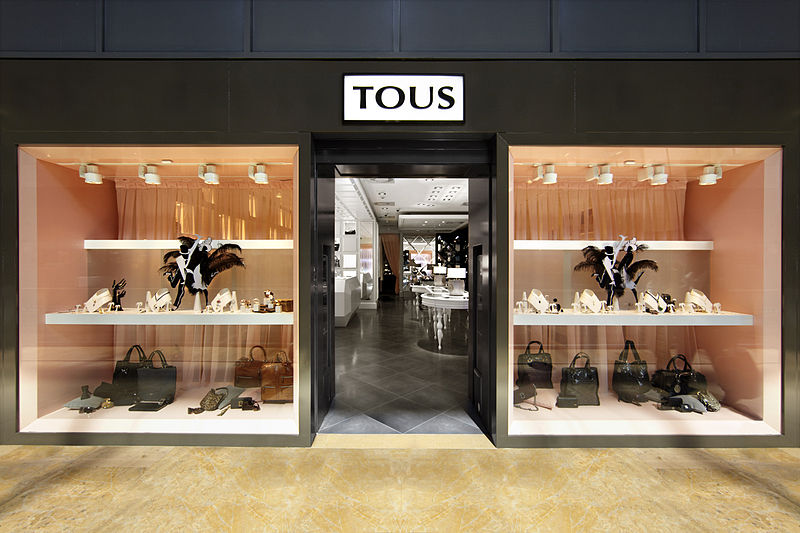
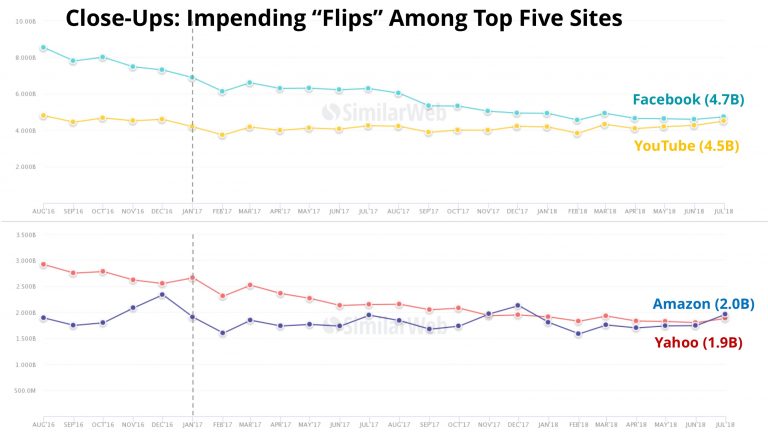
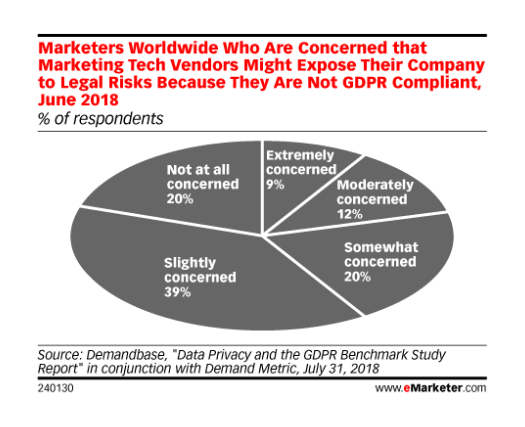
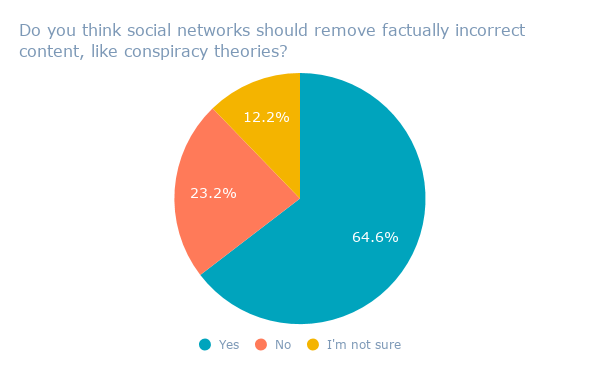

Deje su comentario